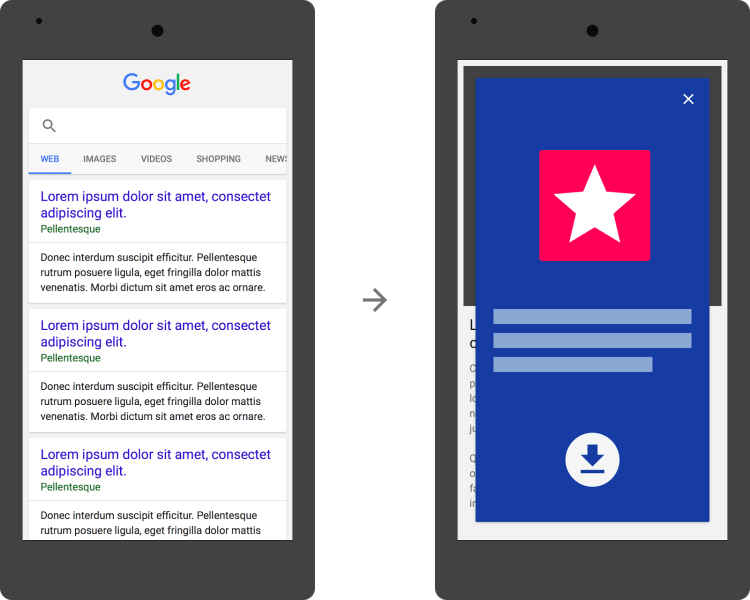Interstitial ads are one of the most popular mobile ad formats used by indie developers because of their high impression rate to increase downloads and revenue. In this article, we will talk about;
- What is an interstitial ad?
- Why developers and marketers prefer interstitial ads – by including the pros and cons of interstitial advertising.
- And how to get the most out of interstitial ads.
Let’s start with the definition and working algorithm of interstitial advertising.
What Are Interstitial Ads?
What is an interstitial ad?
The answer is simple. Basically interstitial meaning is the thing that is placed between layers. Interstitial ads, that has different kinds such as video interstitial ads, are full-screen ad formats covering the interface of an app and appearing at natural app transition points like pausing a game. Users have the option to skip the ad if they want. The main difference between banner ads and interstitial ads is that interstitial ads cover all the screen, and it makes it catchier and more effective. So, in a nutshell, answer to the “What is an interstitial ad?” question is they are full-screen ads that covers the app’s interface.

Image Source: https://support.google.com/admob/answer/6201350
Why Are Interstitial Ads Used?
Mobile app advertising rates keeps moving in favour of interstitial ads. Even, some people call interstitial ads ”revenue doubler”. Developers prefer interstitial ads because of many reasons. Here are the reasons marketers and developers choose interstitial ads.
Reasons Why Marketers Choose Interstitial Advertising
- Interstitial ads have higher click-through rates than banner ads because of interstitial ads’ sizes and bigger impressions on users. Users have 2 options; they will either click the ad or skip the ad to return to the app.
- Developers have larger screen real estate to convince people to take an action on the ad, thanks to more compelling and convincing visuals.
Interstitial advertising have cons too. If you don’t use them according to the best practices, they will cause lower user retention. If you hinder your users from finishing actions, they will uninstall your app. So if you want to get the most out of a interstitial ad, you should follow some rules and best practices.
Is an interstitial ad good choice for your app?
According to Google: “Interstitial ads are best suited for apps with linear user experiences. There should be very clear starting and stopping points in an app. If you have an app that may not meet this criteria (e.g., utility apps like flashlight apps), consider using another ad format such as a banner ad.”
[cta id=”10781″ vid=”0″]
Best Practices of Interstitial Ads
Placement is Very Crucial

Image Source: https://support.google.com/admob/answer/6201350
The first thing you should remember about an interstitial ad is where and when to locate these ads. Here are the best practices for placing the ads.
- Avoid placing an interstitial ad at app loading screen and exiting screen.
- Don’t show them while users are currently completing a task like playing the game.
- If you’re a game app with levels, place the ads after each level completed (or a new level starts).
- Accidental clicks are not useful for you. This is why you should be careful with placement to increase its efficiency.
- To use interstitial ads at a regular interval, you should know the in-app metrics of a single app user, such as average session length. Use an in-app tracking tool to analyze the ad’s efficiency.
- You can also show the ads in user-based pauses.
- Create a flowchart for your app and find the best places to show the ads.
- Gaming apps mostly use interstitial video ads. If you have a gaming app, make sure you are not showing the ad while a user is playing the game. When using interstitial video ads, the ad stays on up to 5 seconds before giving a close option.
Frequency is Important
One of the most important reasons people uninstall apps is intrusive advertising. If you want to benefit from your advertising efforts, you need to avoid overwhelming users with many ads. In interstitial ads, be careful about the frequency to avoid uninstalls.
Here are some best practices to find the best frequency.
- Avoid showing ads after every single action that a user takes. Google suggests that you should place only one interstitial ad after every two user actions within your app.
- Test the frequency of your app to find the best one that avoids a bad user experience. Follow important metrics like click-through rates and retention rate.
- Be careful that you don’t show an interstitial ad one after another.
FINAL THOUGHTS
So, what is interstitial ad? Interstitial ads are one of the most effective ad formats, but when you don’t use them properly, they might cause real interstitials like decreasing engagement and retention rate. If your app is appropriate to use interstitial ads, find out the best practices and get ready for your first interstitial ad.
Here you can find a guide to make interstitial ads.
Good luck! 🙂





